
Next you will learn:
- How to make a simple and effective mole trap from plastic bottles with your own hands, as well as the principle of the construction;
- How to properly install such a trap on the site to reliably catch the pest;
- How can you easily increase the efficiency of a homemade molehill from a plastic bottle by about 2 times;
- Additional ways to catch a mole alive;
- What to do with a mole after its capture and where it is better to let it out so that it definitely doesn’t return back to your site;
- And also what other means to protect against moles can be made independently from ordinary plastic bottles ...
Even if you have already been thoroughly tortured by moles "atrocities" on the site, then do not rush to poison them or set traps on them - this is simply not humane. It is possible to deal with animals very effectively with the help of special traps - it’s not difficult to make such a mole catcher from plastic bottles with your own hands, and given the availability and low cost of materials for it, you can make and install several traps on the site at once, which will significantly increase the chances of catching all the pests.
A mole trap made of a plastic bottle allows you to catch animals alive, and then take them out and release them at such a distance from the site that they can no longer return. This approach is considered the most civilized and humane, because after all a normal person without sadistic inclinations will be much calmer to save the life of an animal that just happened to be on its site, instead of necessarily killing the mole with poison, a trap or a shovel, as it is sometimes done people not burdened with love for animals.


It should be borne in mind that mole traps made of plastic bottles are effectively complemented by traps of other types, working according to other principles. For example, a mole can be caught in a simple plastic bottle, laid on its side on its side, or you can do this with a wide can, bucket or pan buried under the course. The best option is the joint use of such traps (we will talk about this a little later).
But first, let's take a closer look at how to make a reliable mole catcher from a standard plastic bottle, getting a really effective hunting tool. In addition, we will see how to properly install such traps on the site so that they work well.
Plastic bottle mole trap
So, the first type of trap is a kind of analogue of a mole tube-pipe sold for sale, but the “locking” element in it works according to a slightly different principle.
In the photo below, for comparison, a mole head pipe is shown:
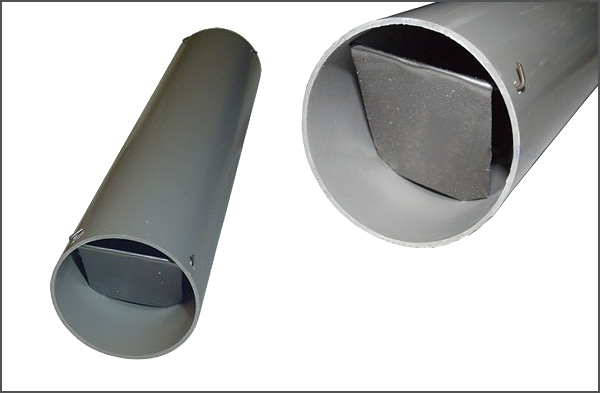
A mole can easily get into such a trap, but it can no longer get out of it. It is implemented as follows:
- A plastic bottle with a capacity of 1.5 liters is taken - it will be the basis of the design. Bottles of a smaller or larger size should not be taken, because the liter one is too narrow, and it is difficult for the animal to get into it, and the two-liter one, on the contrary, is too wide, and often does not fit the animal;
- At the bottle, either the bottom or the neck is cut off - it does not matter. The main thing is to make free entry on the one hand, and on the other there should be a dead end;
- Then a second bottle of the same size is taken, and, in fact, it will clog the mole. She cuts off the dense part of the neck (onto which the lid is screwed), but leaves a “funnel”, and also cuts off the bottom (you can completely cut off the lower half of the bottle);
- In the second bottle, on the tapering part, 10-12 longitudinal incisions are made before moving to a flat part. The result is a kind of long “petals”;
- After that, the second plastic bottle is inserted with the narrowed part into the open passage of the first, and the junction of the two bottles is fixed with tape.
That's all, the mole catcher is ready. If you put it in the mole, the animal will make it into the second (input) bottle: under its pressure, the petals will easily bend and do not prevent him from crawling the junction line, thereby providing unhindered access to the main bottle.

After passing the animal, the petals close again. Here he reaches a dead end, turns around, tries to move back, but rests on narrowed petals, which he can no longer push apart. The mole is caught.
Such a mole trap from plastic bottles is easily made with your own hands in about 10-15 minutes.
On a note
The locking principle described above is called “against wool”. While the petals "stroking" the animal, it calmly moves forward "through the coat." But the animal can no longer get back, because it moves “against the wool” of the valve - the petals rest against its face and do not move apart at all.
Not everyone takes into account that this mole catcher can be easily improved, increasing its efficiency by about 2 times, if the bottom and top of the main bottle are cut off, and then “valves” are arranged on both sides, letting the animal in only. In this case, you won’t have to guess which side the mole will approach the mole head in its underground passage. Moreover, as practice shows, in the presence of several animals on the site, a "double" trap can catch two moles at once.
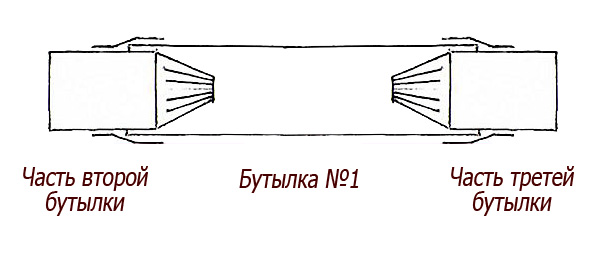
The video at the end of the article shows the process of making a molehill with your own hands. However, it is important not only to make the molehill correctly, but also to correctly install it on the site, since the final result of its work also largely depends on it.
How to catch a mole in such a trap?
A mole trap made of plastic bottles should be installed inside the mole, located between the fresh emissions of the earth. Such passages are sometimes (but not always) clearly visible on the surface of the site, since their arch is slightly raised by the animals during movement, as a result of which a long earthen platen forms over the course.
It is this roller that needs to be carefully excavated (the stroke itself is located at a depth of about 10-15 cm). Then the course needs to be slightly cleared from the ground and slightly deepened in the place where the trap will be installed.

It is better to dig out the underground passage of a mole with a garden scoop. It is undesirable to use a shovel, since the course itself is severely damaged by it, and the mole in the future may not “want” to move along it and get into a trap.
Important:
Do not install a mole catcher from a plastic bottle at the entrance to the tunnel or in a pile of earth poured out by a mole. Such a molehill may not be used anymore, but the underground passage itself will be inspected regularly. Therefore, the mole catcher is located precisely in the course between the outlets of the animal to the surface.
Before installation, it is advisable to pour a little earth into the mole catcher so that the animal does not notice a sharp transition of normal soil into slippery plastic.
It is also useful to put several earthworms in the main bottle - the mole can smell them well and can neglect suspicions when touching the plastic if it smells of food.
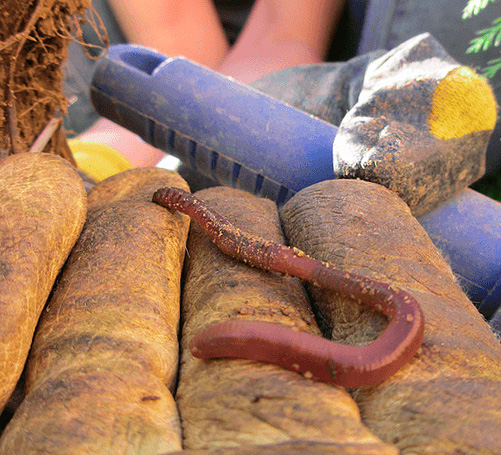
The trap itself is laid in motion, its valve goes in the direction from which the animal is supposed to approach it. If the trap is two-sided, then its orientation does not matter.
From above the mole trap should be sprinkled with earth (but so as not to fill the entrances to it!) And covered with a wooden shield, or with a very dense opaque cloth. The main task in this case is to eliminate the light in the trap so that it is as dark as in the rest of the course (although it is believed that the moles are blind, but this is not entirely true - they are able to distinguish between light and darkness, and also see the outlines items).
After this, the trap should be checked two to three times a day.Most often, the mole comes in at night or in the evening.
On a note
Keep in mind that because of the accelerated metabolism, the mole cannot starve for a long time. He may not survive even 24 hours in the mole catcher, and therefore it is necessary to check the trap at least twice a day, and immediately after detecting the animal, take it out of the site as soon as possible and release it into the wild.
Of course, the more traps are installed on the site, the faster it will be possible to catch all moles (often only one mole lives on a small site, since these animals are very jealous of the protection of their territory). If the mole catcher is made in a single copy, then with a certain probability it will have to be transferred from one move to another, if it remains empty for more than 4-5 days.
How to catch a mole in a jar?
There is another way to catch a mole many times tested in practice: in a jar, pan, bucket or plastic bottle with a cut off top. Such a mole catcher is also easily realized with your own hands - for this you will need to make a kind of hunting pit.
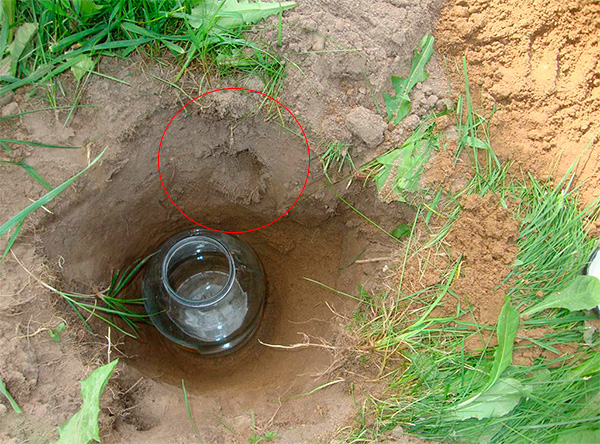
Consider the manufacturing procedure for this mole head:
- You can take a large five-liter plastic bottle from under drinking water, you need to cut off the tapering top. Some gardeners also successfully use three-liter glass jars - their width is quite enough to get a mole (the animal is comparable in size to a rat). You can also use a suitable pan or bucket, it is only important that the height of the trap is at least 25-30 cm, otherwise there is a possibility that the mole will get out of it;
- Then the mole's course is excavated and a hole is excavated, identical in diameter and height to the trap;
- A prepared mole catcher (capacity) is inserted into the pit;
- After that, cracks along the edges of the trap are filled with earth, the earth is rammed a little here. As a result, the edges of the container should be hidden by a rammed earthen roller so that the mole does not feel them;
- From above, the trap is covered with a wooden shield or with a dense cloth so that the light does not penetrate the course and does not scare away the animal.
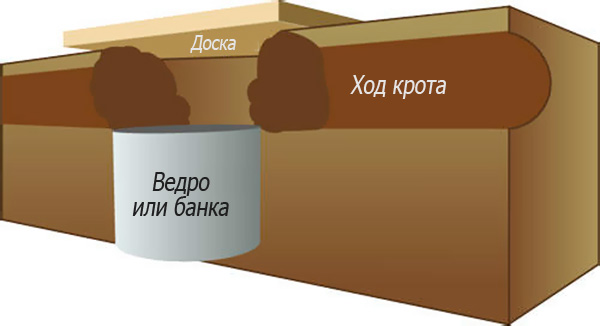
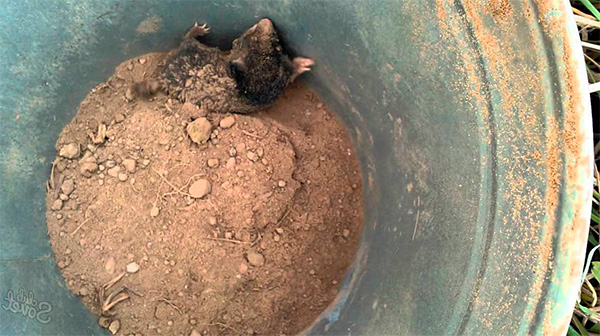
Such a mole catcher, installed in the gap of the underground passage of the mole, works even simpler than the above of two plastic bottles. The animal simply falls into the jar (or other deep capacity), moving along its course.
You also need to check the trap at least twice a day, so as not to starve the animal that has fallen.
About the effectiveness of plastic bottle traps
As practice shows, mole catchers made of plastic bottles, made by hand, work no less efficiently than various flayer crushers, traps and self-arrows. Moles fall into bottles as often, and the overall reliability of the structure is determined not so much by its operability as by the proper installation of a trap in the garden area.

In particular, an important role is played by the choice of the mole in which the trap will be installed. If the move is old and rarely visited by the beast, then the mole catcher can stand for several days in vain, and the disappointed gardener will eventually reject the remedy, recognizing it as ineffective.
In addition, a horizontal trap with one trap entrance may not work just because the mole will approach it every time from the other side - from the dead end. Thus, the animal will not fall into the trap itself, and if it detects an obstacle, it may also try to make a detour.
Practice shows that trapping pits from cans and pans dug under the canals work more effectively as a whole than “anti-wool” traps. The mole does not have time to notice them, and cannot avoid getting into such a mole catcher.
What to do with a caught animal?
A mole caught in a mole trap must be taken out of the site, taken to a distance of about 1 km and released.
When releasing the captive, you need to be careful: moles have very sharp, albeit small, teeth that they can bite quite painfully (After all, moles are, first of all, predators). The epidemiological danger of moles is poorly studied, and you can never guarantee that an animal will not give a person any bacterial “joy” when bitten.
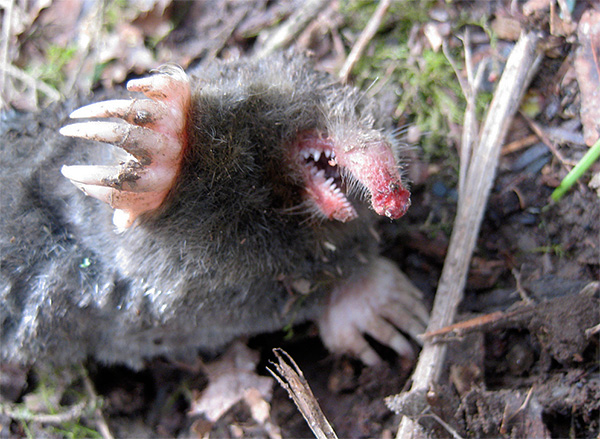

It is most reasonable to take a mole from the site right in the mole catcher, and at the place of release just open it and gently shake the animal to the ground. It is better to let out a mole among dense grass or in the forest, where it has more chances to go unnoticed by predators.
The release operation itself should be carried out immediately after the capture is detected. As noted above, the extra few hours of hunger can be fatal for a mole.
Are moles returning to their sites and how to prevent their reappearance?
The mole is a small animal, although mobile, but it cannot travel long distances. Young animals, leaving the maternal area in search of unoccupied land, may be 1.5-2 km away from the place of birth, but adults who have already settled somewhere moles are constantly on their territory with an area of about a hectare.
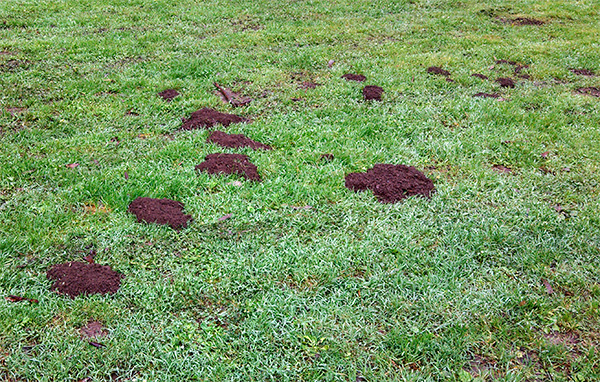
This means that if a mole is released a kilometer from the place of capture, then it will not return to the previous site. If you release it right behind the fence, and the fence itself does not have a foundation, then with a high probability the mole will have to be re-caught.
In general, it is useful to keep in mind that preventing moles from entering the site is easier than fighting these animals later. Even if the animals have already appeared in the garden and harm, they can and should be caught and taken away, however, measures should be taken to reliably protect the site: enclose it, albeit not with a powerful but impassable foundation, or simply dig around the perimeter to a depth of 70-80 cm strong fine-mesh plastic mesh (with a mesh size of not more than 1 cm).

Such measures will guarantee that after the capture and removal of all moles from the site, other animals will not penetrate it again. Otherwise, you will have to catch moles constantly.
As for the various mole repellers, they also sometimes give a good result, although they do not provide absolute protection for the site. By the way, you can also make them yourself from plastic bottles ...
Plastic bottle repellers: do they help?
There are two ways to scare away moles with plastic bottles:
- To make spinners from bottles that spin in the wind, make noise and scare animals (moles hear well);



- Or you can simply lay out closed plastic bottles in large quantities throughout the entire area. With constant temperature changes in the morning, afternoon, evening and night they emit cod, which, presumably, also scare away animals.

Many gardeners and gardeners note that such home-made repellers are really effective and help get rid of moles on the site. However, at the same time, many reviews indicate a lack of effect from the use of these funds.
Apparently, the truth is somewhere in the middle: moles can really be afraid of the noise created by these devices, and leave the site in search of a more comfortable area. But they can also ignore repellers, especially if there is a problem of survival due to lack of food. Therefore, the use of such repellers is a kind of lottery: it can help, or it may not give any visible result.
Other types of traps, humane and inhumane
The pipe trap works according to the same principle as home-made traps made of plastic bottles. Only in it does the animal push the door that easily opens inward and slams behind it, penetrates the pipe, and cannot open the same door from the inside.
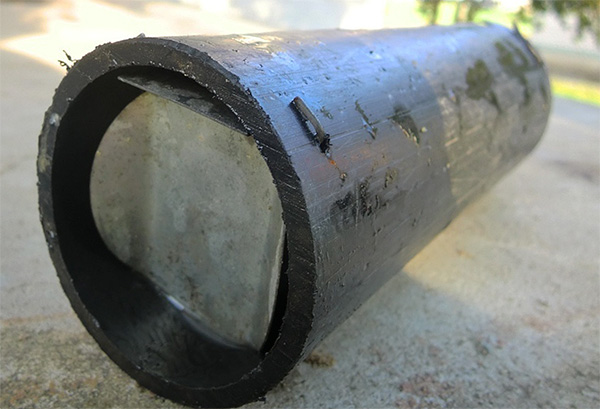
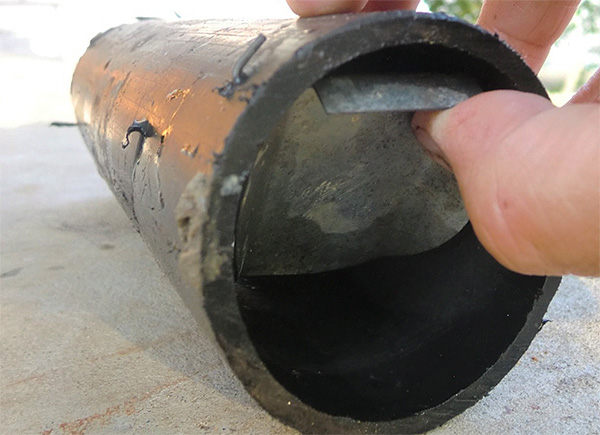
There are also inhuman traps for moles that simply kill animals:
- Spring traps;
- Loop traps;
- Scissor traps;
- Harpoon traps (crosshairs).
Some do it yourself or buy ready-made ones.However, before using them, think: why mercilessly kill warm-blooded animals just because they are for some reason bothering you. And even more so it is not worth killing animals just because laziness is to catch them alive and take them out of the area.

The effectiveness of all these lethal traps is approximately the same and does not differ from the efficiency of the home-made live traps. You should not expect that if you didn’t catch a mole with a correctly made construction from a plastic bottle, then a trap will certainly kill him. It is wiser to figure out why the trap turned out to be ineffective (wrong choice of move, errors in placement or manufacturing), correct the flaws and catch the pest alive.
In any case, no matter what mole traps are used, without effective measures to protect the site, the results of their use will be temporary, and animals will have to be caught constantly, worrying about a spoiled crop. Therefore, first you should take care of protecting the site from the penetration of moles on it, and only then catch the animals. About how to effectively protect the site from moles - read in other articles on our website.
If you have personal experience using homemade molehills, then be sure to leave your review in the comment box at the bottom of this page.
A good example of scaring moles with ordinary plastic bottles
Interesting video: make a mole-tube pipe with your own hands

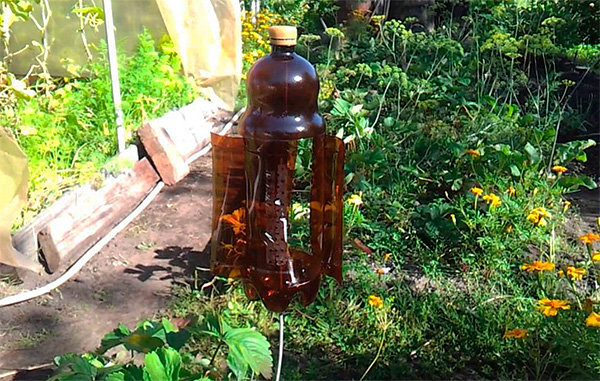

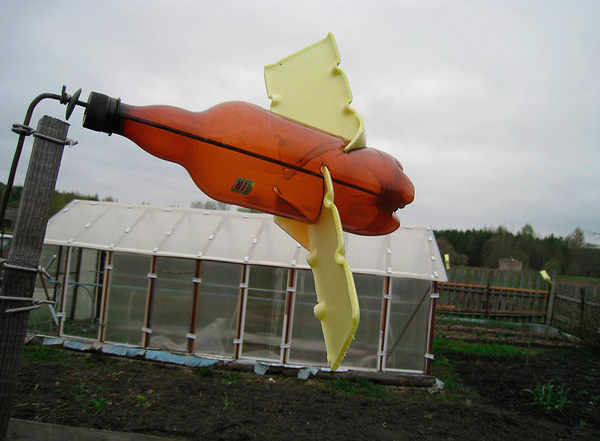




It is tempting and interesting, I’ll go catch. Thanks for the advice.
At the expense of the futility of setting up a non-lethal trap at the end of the tunnels (where the mole throws the earth to the surface). Checked - do not catch. He loads the whole 3-liter jar and tamps it 🙂
He made traps of all types, bought electric repellers, and still did not catch a single mole.
I bought a mole repeller in a store. I chose the best, and with vibration, and with sound nasty signals. So my mole not only didn’t leave, but he called friends. After three days, the number of molehills and moves increased three to four times. He spat on humanity, began to put carbide in the moves, so again to no purpose, only new corridors appeared. Looks like it’s very good for him (the mole) with me.
You, Denis, have fed the troll above the roof, but you didn’t catch the mole yourself. But you have a distinguishing feature, you love the red word - "so he called friends." You are talking nonsense, dear. However, it’s not your fault that historical roots are calling you to this stupid occupation. We kindly request, try to catch at least one, I assure you that this is no less exciting hunting than fishing. The animals are pretty smart, and the “I'm catching up, run away” tandem works very well with them.
I catch moles with a pipe with lids, it doesn’t work in a jar. Here, now I’ll check the plastic bottle. Check - unsubscribe.
A better trap.
The bank does not pass - the mole really covers it with earth and makes a detour. A bottle or pipe - you have to try ...
Carrying on advertising, I bought as many as two electronic repellers. The result is zero! A bed of good varietal strawberries literally died from underground evil spirits. Manufacturers and sellers of these devices, in my opinion, are just crooks. I will write a complaint. I know that it will not help, but at least someone will be ashamed. I will set traps. To hell with humanity!
An idea confirmed by fact. I drilled holes for fence poles - the next morning in two I found dead moles! If you drill a mole tunnel, then all moles on both sides will be in the pit. This is not a can or even a bucket for you. Depth is not less than 50 cm, for reliability it is possible to roll a tube from a film and lower it into a hole. You can figure out how to pull them out alive - this is not a problem.
P.S. Lift for the mole! Take a milk plastic liter bottle, cut off the conical part, tie the rope and lower the finished elevator car to the bottom of the pit. A mole falling into it will wait for your arrival. You pick it up and release it back onto the strawberry bed! The mole will be very happy.
I tried the jar and the pipe. Zero effect, bows. I hit with a crossbow. The people, and the mole and mole rat are different creatures?
A bucket was buried in me, and cynically made a hill of twenty centimeters above it. Put a capacity of seventy centimeters. I'll see what happens.
A wire trap for moles helps, only you need to set at least 3 pairs of traps.
He put the speakers in the holes. Everywhere they write that they scare away! Connected to a radio. They work for days. But they are not afraid of them, they are falling asleep with earth (thank God that they at least do not relieve the need for these speakers).
In support of Denis. Installed an expensive mole repeller. And not for the red word, but in fact - there are more land extensions around it. Moles seem to mock us. With the bank, I did not succeed. Therefore, I want blood. I myself can’t make any stun gun, I’m looking for where to sell it. And here it’s never a humanist when your 18 rose bushes are scattered up and down, or a freshly made lawn that is cherished for the second season. Young landings are particularly affected. And yes! How much I will worry about the fact that he got into a jar and died of hunger ...
What are they still terrible animals on the face ...
I myself suffer. Not caught. They almost threw a Thumbelina ...
SECOND YEAR (!) I try to catch by all available humane methods. The more traps I set, the more he spoils me on the site. After the next set trap, a new bed appears to be plowed. And all! Snake, from start to finish. Already twice planted carrots and beets. It feels like he is taking revenge on me for this. The neighbor is generally surprised - "maybe he is looking for a treasure." He lives only on my site, no neighbors.
About Thumbelina laughed! I was also advised to use fishing hooks-tees for their fishing. He himself made repellers from aluminum beer cans, hanging two pieces on stuck pegs. On a thread. In the wind, they work in the same way as PET bottle turntables. But what if there is no or weak wind? Question…